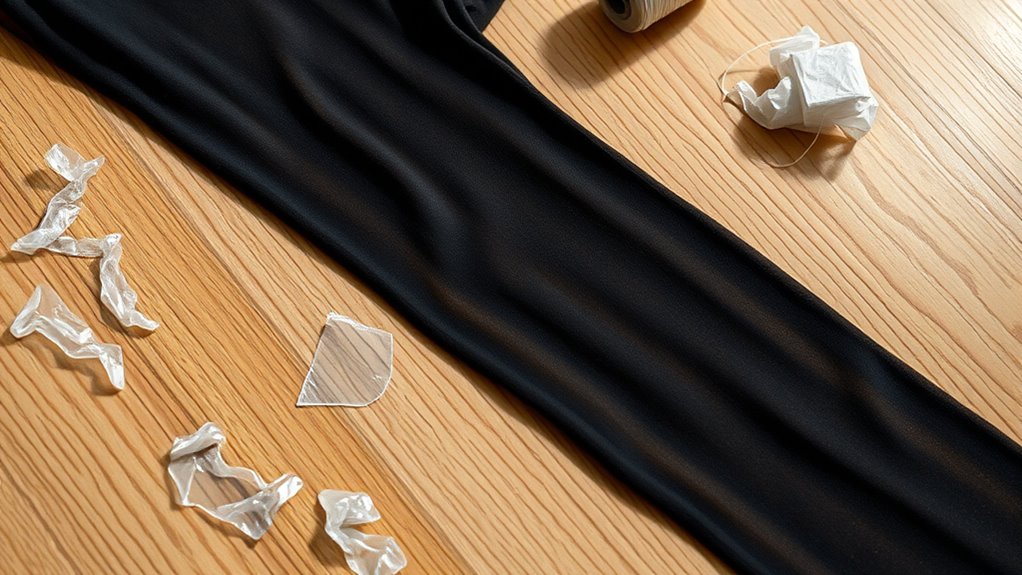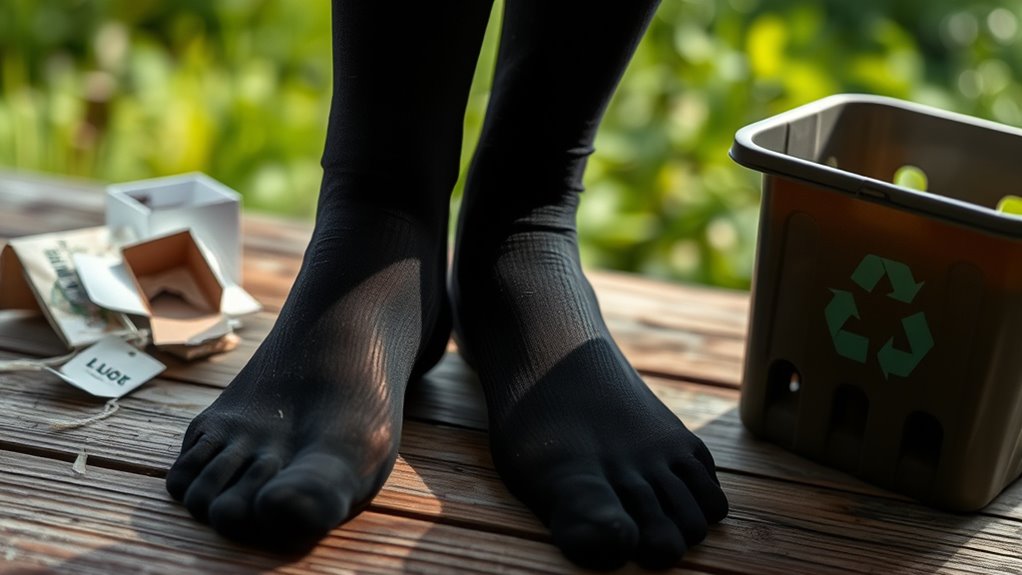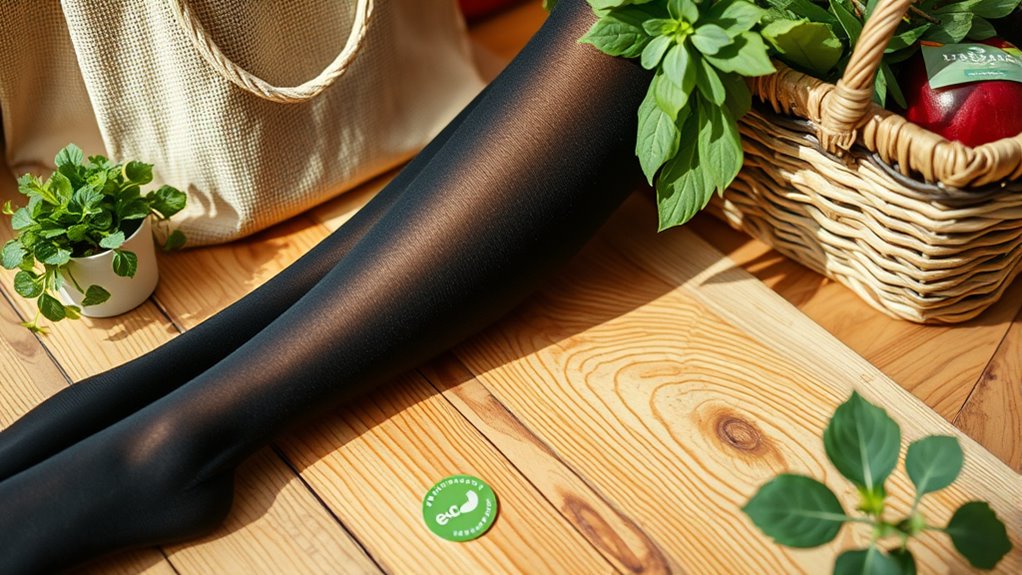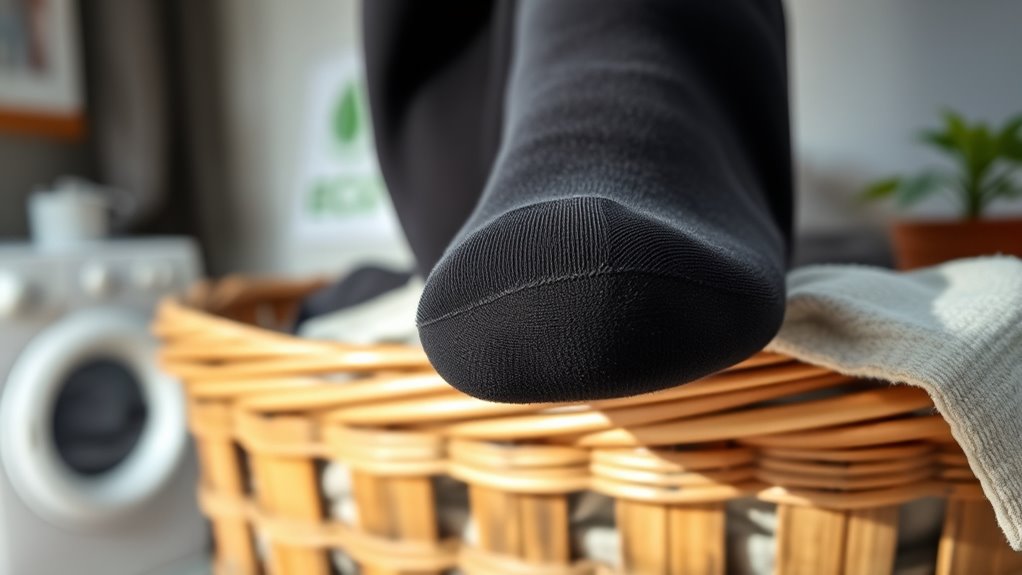The carbon footprint of one pair of tights depends on your choices—material type, manufacturing methods, transportation, and disposal. Opting for tights made from recycled or natural fibers, supporting eco-friendly brands, and choosing local production can markedly lower your impact. Proper care and recycling extend their lifespan and reduce waste. Smaller actions add up, making a big difference. To discover practical tips and sustainable options, keep exploring how you can make environmentally mindful wardrobe decisions.
Key Takeaways
- The production of synthetic fibers like nylon and polyester contributes significantly to tights’ carbon footprint due to high energy use.
- Transportation and shipping, especially fast delivery, add substantial emissions to the overall environmental impact.
- Choosing tights made from recycled or natural fibers and supporting local brands can reduce their carbon footprint.
- Eco-friendly dyes and sustainable manufacturing practices lower water, chemical, and energy consumption during production.
- Proper care, extended wear, and recycling help decrease waste and lessen the environmental impact of tights over their lifespan.
Understanding the Materials Behind Tights

Understanding the materials behind tights is essential because the production and sourcing of these fibers considerably impact their environmental footprint. The fiber composition determines not only how the tights feel and fit but also their overall sustainability. For instance, tights made from nylon or polyester often derive from synthetic, petroleum-based sources, which require significant energy to produce. On the other hand, natural fibers like cotton or recycled materials tend to have a lower environmental impact, but their durability varies. Material durability is vital because longer-lasting tights reduce the need for frequent replacements, cutting down on waste and resource use. Additionally, the choice of fiber technology can influence the recyclability and biodegradability of tights, further affecting their ecological footprint. By being aware of the fiber composition and durability, you can make more eco-conscious choices that help lessen the carbon footprint of your wardrobe.
The Manufacturing Process and Its Environmental Impact

When you look at how tights are made, you should consider where the raw materials come from and how much energy the process requires. Manufacturing often depends on energy-intensive steps that increase its environmental footprint. Understanding these factors helps you see the true impact behind your favorite pair of tights.
Raw Material Sourcing
The environmental impact of sourcing raw materials for tights begins long before production starts, as the extraction and cultivation processes require considerable resources and often lead to ecological damage. Choosing recycled fibers helps reduce waste and lowers the demand for virgin materials, markedly decreasing the carbon footprint. Opting for tights made from recycled nylon or polyester means less energy consumption and fewer emissions. Additionally, ethical sourcing ensures that raw materials are obtained responsibly, with fair labor practices and minimal environmental harm. Supporting brands that prioritize sustainability in their raw material procurement not only reduces your tights’ overall impact but also promotes better environmental and social standards. By paying attention to raw material sourcing, you take an active step toward more sustainable fashion choices. Incorporating high-quality, eco-friendly materials can further lessen your environmental footprint and promote a healthier planet.
Energy-Intensive Production
Manufacturing tights is an energy-heavy process that substantially contributes to their overall environmental footprint. During production, energy consumption peaks due to processes like spinning, weaving, and dyeing. Using energy-efficient dyes can markedly reduce water and energy use while maintaining vibrant colors. These dyes require less heat and chemicals, lowering pollution and resource waste. Additionally, switching to eco-friendly packaging minimizes waste and carbon emissions associated with transportation and disposal. Modern factories are increasingly adopting renewable energy sources, which helps cut down the carbon footprint of manufacturing. An emerging trend is the use of sustainable materials in production, further reducing environmental impact. By choosing brands that prioritize energy-efficient dyes and eco-friendly packaging, you support sustainable practices. Your choices can encourage manufacturers to continue improving production methods, reducing the environmental impact of producing tights and making your wardrobe more eco-conscious.
Transportation and Its Role in Emissions

Transportation substantially contributes to the overall emissions of tights, from raw material shipping to final delivery. You can reduce your footprint by choosing brands that optimize their supply chains and use eco-friendly shipping methods. Every step you take can help lower the environmental impact of your tights. Additionally, selecting products from brands that utilize efficient transportation can significantly decrease the carbon footprint associated with your purchase.
Manufacturing Supply Chain Emissions
Although transportation might seem like a minor part of the overall manufacturing process, it actually plays a significant role in the carbon footprint of tights. The supply chain involves multiple stages, from sourcing raw materials to delivering finished products, each contributing emissions. By prioritizing fiber innovations, manufacturers can reduce energy use and emissions during production. Ethical sourcing also helps, ensuring materials come from environmentally responsible sources, which can cut down on transportation-related emissions by shortening supply routes and supporting local industries. Streamlining the manufacturing supply chain minimizes unnecessary transportation, lowering overall emissions. Being mindful of these factors allows you to choose tights made with sustainable practices, reducing your environmental impact. Cutting emissions at every step makes a meaningful difference in lowering the carbon footprint of your tights.
Shipping and Delivery Impact
Have you ever considered how your tights reach your closet? Shipping and delivery play a big role in their carbon footprint. Fast delivery often means more emissions because of expedited transport methods, which consume more fuel. The packaging waste from shipping adds to environmental impact, especially if excessive or non-recyclable materials are used. Choosing slower, standard shipping options can reduce emissions, as these methods typically have higher load efficiency and lower fuel consumption per item. Additionally, minimizing unnecessary packaging or opting for eco-friendly materials decreases waste. Being mindful of delivery speed and packaging choices can cut down the environmental impact of your tights before they even arrive. Small adjustments in your shipping preferences can make a significant difference. Considering transportation methods when selecting your shipping options can further help reduce your overall carbon footprint.
Reducing Transportation Footprint
Ever wonder how your choice of transportation methods impacts the carbon footprint of your tights? You can reduce emissions by prioritizing local production, which shortens supply chains and cuts transportation distances. Opt for brands that use sustainable packaging to minimize waste and energy use during transit. Carpool or choose direct shipping options to lower the emissions associated with multiple delivery stages. Support companies committed to eco-friendly logistics, such as those utilizing electric vehicles or optimized routes. These steps help decrease the carbon footprint tied to transportation, making your fashion choices more sustainable. Additionally, understanding the market volatility of transportation emissions can help you make more informed choices about your supply chain. By making mindful decisions about where and how your tights are transported, you actively contribute to reducing overall emissions and promoting a greener planet.
The Lifecycle of a Pair of Tights

The lifecycle of a pair of tights begins long before you wear them, starting with raw material extraction and manufacturing. Cotton, nylon, or other fibers are sourced, often involving energy-intensive processes. During production, brands with eco label certifications prioritize sustainable practices, reducing environmental impact. Once manufactured, tights are packaged in recyclable packaging to minimize waste. These eco-friendly choices help lower the overall carbon footprint. After purchase, care routines like washing in cold water and avoiding dry cleaning extend their lifespan, reducing the need for frequent replacements. Additionally, understanding regional divorce statistics can inform consumers about the importance of sustainable and responsible choices in their lifestyle. Finally, at the end of their life, tights should be disposed of responsibly, ideally through textile recycling programs. Understanding this lifecycle highlights opportunities to make more eco-conscious decisions at every stage.
Indicators of Eco-Friendly Tights

What signs indicate that tights are eco-friendly? Look for textile innovation that prioritizes sustainable materials and production methods. Eco label certifications are key indicators, as they verify environmental standards. These certifications often require transparent supply chains and reduced chemical use. Additionally, eco-friendly tights often feature innovative fibers like recycled nylon or organic cotton. Check for brands that highlight their commitment to sustainability through clear labeling. A strong indicator is the use of eco-conscious dyes, which minimize water and chemical waste. Finally, transparency about manufacturing processes and certifications shows a genuine dedication to reducing environmental impact. Incorporating sustainable manufacturing practices is another important aspect that reflects a brand’s commitment to eco-friendliness. By paying attention to these signs, you can confidently choose tights that align with eco-friendly values and lessen your carbon footprint.
Practical Tips to Reduce Your Tights’ Carbon Footprint

To effectively reduce your tights’ carbon footprint, start by choosing eco-friendly options made from sustainable materials and produced with environmentally responsible methods. Look for tights created through fashion recycling, which repurposes fabrics and minimizes waste. This process reduces the environmental impact associated with new production. Additionally, opt for tights dyed with eco friendly dyes, as these use less water, energy, and harmful chemicals. Proper care also matters: wash your tights in cold water, avoid excessive washing, and hang them to dry instead of using a dryer. These small steps extend their lifespan and reduce the need for frequent replacements. Incorporating sustainable textile choices into your wardrobe can further lower your overall environmental impact. By making conscious choices and supporting sustainable practices, you considerably lower the carbon footprint of your tights.
Choosing Sustainable Alternatives and Brands

When selecting tights, prioritizing brands that emphasize sustainability can make a significant difference. Your choices reflect your commitment to fashion ethics and influence the industry’s shift toward greener practices. To make more conscious selections, consider researching brands that use eco-friendly materials like recycled fibers or organic cotton. Look for certifications such as GOTS or Fair Trade, which ensure responsible production. Being aware of a brand’s transparency about their supply chain boosts your consumer awareness and helps you avoid greenwashing. Additionally, choose companies committed to reducing waste and carbon emissions. Supporting sustainable brands encourages others to follow suit, amplifying positive change. By making these informed decisions, you contribute to lowering your overall fashion footprint and promoting ethical manufacturing. Incorporating sustainable materials into your wardrobe choices can further reduce environmental impact.
How Small Changes Can Make a Big Difference

Even small changes in your tights habits can considerably reduce your environmental impact. By choosing tights made with fiber innovation, you support sustainable materials that lower carbon emissions. Adjusting your consumer behavior—like wearing tights longer or opting for higher-quality pairs—can make a huge difference. Remember, collective small actions add up.
| Small Change | Impact | Emotional Benefit |
|---|---|---|
| Repair instead of discard | Reduces waste and prolongs use | Feel proud saving resources |
| Wash in cold water | Saves energy and fibers | Enjoy guilt-free comfort |
| Choose eco-friendly brands | Supports sustainable fiber innovation | Feel good about your choices |
| Use tights longer | Lowers demand for new production | Experience mindful consumption |
Frequently Asked Questions
How Does the Dyeing Process Affect Tights’ Overall Environmental Impact?
The dyeing process impacts tights’ environmental footprint considerably. You might not realize that dyeing chemicals can pollute water sources if not managed properly. Additionally, high water consumption during dyeing adds to environmental strain. Choosing tights made with eco-friendly dyes and sustainable practices reduces this impact. By supporting brands that prioritize water conservation and safe dyeing chemicals, you help lessen the environmental harm associated with producing tights.
What Is the Average Lifespan of Eco-Friendly Versus Conventional Tights?
Did you know eco-friendly tights last about 2-3 times longer than conventional ones? You’ll notice that their fabric durability means fewer replacements, saving you money and reducing waste. On average, eco-friendly tights have a lifespan of around 6-8 months, while conventional tights might only last 2-4 months. Plus, their recycling potential is higher, making them a better choice for both your wardrobe and the environment.
Can Washing Habits Significantly Influence the Tights’ Carbon Footprint?
Your washing habits can definitely impact the tights’ carbon footprint. By practicing water conservation and using eco-friendly detergent, you reduce energy use and pollution. Washing tights in cold water, avoiding unnecessary washes, and using a full load help lower energy consumption. Choosing biodegradable detergent minimizes environmental harm, making your routine more sustainable. These small changes make a big difference in reducing your overall carbon footprint.
Are There Certifications to Identify Truly Eco-Friendly Tights?
Imagine you’re in the days of knights and castles, seeking trustworthy signs of quality. Today, you can look for sustainable certifications to verify eco label credibility. Certifications like GOTS, OEKO-TEX, and Fair Trade help identify truly eco-friendly tights. Always check these labels on packaging to guarantee your purchase supports environmentally responsible practices, giving you confidence in making sustainable choices that lessen your fashion footprint.
How Do Packaging Choices Impact the Environmental Footprint of Tights?
Your packaging choices considerably impact the environmental footprint of tights. Opt for sustainable packaging made from biodegradable materials, which break down naturally and lessen landfill waste. By choosing brands that prioritize eco-friendly packaging, you reduce plastic use and encourage sustainable practices. Small changes like these make a big difference in reducing overall environmental harm, helping you support a greener future while still enjoying your favorite tights.
Conclusion
Did you know that producing a single pair of tights can emit up to 8.3 pounds of CO₂? By making smarter choices—like opting for eco-friendly brands and reducing unnecessary wear—you can drastically cut your environmental impact. Small changes, such as washing tights in cold water or choosing sustainable materials, add up over time. Every step you take helps protect the planet. So, next time you shop, think green and make a difference!









